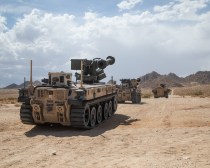Pentagon about to pick systems for Replicator initiative

The Pentagon in the coming weeks will select which programs and systems will be fast-tracked under the department’s Replicator initiative that aims to rapidly field thousands of low-cost, autonomous systems, Deputy Secretary of Defense Kathleen Hicks told reporters Tuesday.
Hicks first announced the initiative in August, with the stated goal of delivering “attritible” capabilities to U.S. Indo-Pacific Command in 18 to 24 months to help counter China’s military buildup.
“With Replicator, our goal really is … to get to scale fast,” she said at a Defense Writers Group meeting on Tuesday. “We will select the candidates within the next about three weeks.”
However, the DOD isn’t expected to be forthcoming, at least publicly, about specific systems or programs that have been chosen.
“I would not necessarily say the candidates will be announced. We’re being very careful, as you know, about the way in which we talk about Replicator. Our goal here is an operational goal, which is in addition to the acquisition cycle, and that operational goal is to create dilemmas for China and any other competitor who might look at this approach and try to undermine it. So, we will be very clear and transparent with Congress. I’ve talked to Congress in classified sessions on this. But how we choose to speak about it, in terms of the particular programs or projects that we’ll be accelerating through Replicator is to be determined,” Hicks told reporters.
Replicator isn’t a program of record but rather an effort to give a boost to technologies that are already in the works so they can be fielded faster in larger quantities than they would otherwise if they weren’t given special attention.
“We’re looking at how we burn down within those programs that we have already in the system, how we burn down risk against them. That risk can come from, again, the manufacturing process, it could be a software design issue, could be the requirements process. The vice chairman [of the Joint Chiefs of Staff] and I … can sit on top of all that and say, ‘Take that barrier away, take this barrier away.’ We’ve already done that with another initiative we’ve had called [Competitive Acquisition Pathfinders], and we’ve shown we can save years off of programs by just taking the bureaucracy out … That’s what we’re doing with Replicator. And we’ve also picked an area that is very important to Indo-Pacom and other [combatant commands] that will really move the needle with very low dollars,” Hicks said.
Cost is a key consideration for Replicator candidates. They won’t include the pricier unmanned platforms that the Pentagon is pursuing, such as the Air Force’s collaborative combat aircraft (CCA), which are expected to cost tens of millions of dollars per drone.
The unit cost of a particular system under the initiative will depend on the program or project, according to Hicks. However, the department is generally looking for capabilities that would cost tens of thousands or hundreds of thousands of dollars per unit — not millions, she noted.
“There are a lot of other things going on in autonomy. You can think about things like CCA that the Air Force is after that are not meant to be attritable, but we’re really focused down on these much smaller — generally smaller and certainly less expensive systems,” Hicks told reporters.
DOD officials are looking at platforms across “all domains,” not just unmanned aerial vehicles, as they consider Replicator candidates, she noted.
The department isn’t asking for a new chunk of money for the first tranche of projects that are about to be selected, according to Hicks. It plans to focus on programs that have already been funded in fiscal 2023 or were included in the Pentagon’s fiscal 2024 budget request (Congress hasn’t yet passed a full-year defense appropriations bill for 2024, and federal agencies are currently operating under a continuing resolution).
“With ’23 money, there are projects in the system, and/or there are projects in our ’24 request. They’re already there. The question is, are they facing barriers — which almost all programs do, whether they’re programs of record or other acquisition strategies — that could inhibit their ability to deliver quickly? Or put another way: Are there opportunities to pull them left or increase their scale? That could be new additive manufacturing approaches, you could think of a lot of things that help us burn down risk … That’s what the teams are looking at now — which programs are ripe for intervention to help them?” she said.
However, the fiscal 2025 DOD budget request, which is expected to be delivered to Congress early next year, may include new funding specifically aimed at boosting programs under the Replicator initiative, including potentially a second tranche of systems.
“For ’25, we’ll be we’ll be looking at those systems [that are about to be selected] and then … maybe an additional tranche of systems that aren’t quite that mature today but we think, again, can still deliver within the 18 to 24 months, you know, marked from August [when the Replicator timeline was first announced]. We’ll add funds as needed in there or maybe the services have already put the funds there. [And] we’ll be able to tell the Hill what that looks like,” Hicks said.
It’s too soon to tell exactly how much money will ultimately be spent on capabilities that fall under Replicator, according to Hicks. However, she suggested it would be a small fraction of the overall Pentagon budget.
“We would expect that we’re talking about something like less than 0.5% of the defense budget. But we think they’re going to have a significant impact on the battlefield and again, can be delivered near term,” she said. “We would be able, once we’ve selected all the systems and mostly in retrospect, be able to say: ‘This [amount] is probably the total dollar value of systems that we advanced using the Replicator initiative.’”
For context, Congress appropriated about $852 billion for the Pentagon in fiscal 2023. The Biden administration requested $842 billion for the department in fiscal 2024, not including supplementals. That would suggest that the Pentagon could end up spending a few billion dollars on the first round of Replicator systems.






